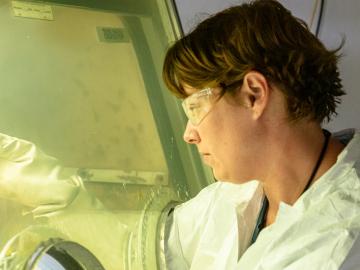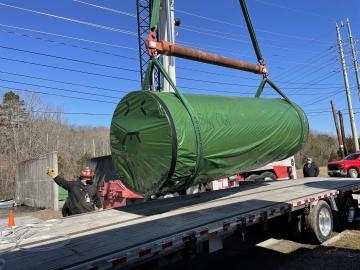Filter News
Area of Research
- (-) Fusion and Fission (14)
- (-) Isotopes (12)
- (-) Neutron Science (16)
- Advanced Manufacturing (7)
- Biology and Environment (37)
- Building Technologies (1)
- Clean Energy (69)
- Computational Biology (1)
- Computational Engineering (2)
- Computer Science (4)
- Electricity and Smart Grid (1)
- Fusion Energy (1)
- Materials (15)
- Materials for Computing (18)
- Mathematics (1)
- National Security (7)
- Nuclear Science and Technology (1)
- Quantum information Science (3)
- Sensors and Controls (1)
- Supercomputing (21)
- Transportation Systems (1)
News Topics
- 3-D Printing/Advanced Manufacturing (3)
- Advanced Reactors (2)
- Artificial Intelligence (2)
- Biology (2)
- Biomedical (4)
- Chemical Sciences (2)
- Computer Science (5)
- Coronavirus (2)
- Energy Storage (1)
- Environment (1)
- Fusion (8)
- High-Performance Computing (2)
- Isotopes (11)
- ITER (4)
- Materials (4)
- Materials Science (6)
- Microscopy (2)
- Nanotechnology (3)
- National Security (1)
- Neutron Science (14)
- Nuclear Energy (5)
- Physics (1)
- Quantum Computing (1)
- Quantum Science (2)
- Security (1)
- Space Exploration (3)
- Sustainable Energy (1)
- Transportation (2)
Media Contacts

It’s elemental — scientists agree that the periodic table is incomplete. And when it comes to unveiling parts of the periodic table yet undiscovered, ORNL is doing some heavy lifting.

In experiment after experiment, the synthetic radioisotope actinium-225 has shown promise for targeting and attacking certain types of cancer cells.

A team led by the U.S. Department of Energy’s Oak Ridge National Laboratory demonstrated the viability of a “quantum entanglement witness” capable of proving the presence of entanglement between magnetic particles, or spins, in a quantum material.


ORNL's Larry Baylor and Andrew Lupini have been elected fellows of the American Physical Society.

Staff at Oak Ridge National Laboratory organized transport for a powerful component that is critical to the world’s largest experiment, the international ITER project.

Diego Del-Castillo-Negrete, a distinguished staff member in the Fusion Energy Division, was cited for Outstanding Technical Achievement – National Laboratory. He will be recognized during the GMiS annual conference, which will be held virtually Oct. 11-22. The HENAAC awards program is in its 33rd year.

A 25-year career with the U.S. Navy, commanding combat missions overseas, brought Tom Kollie back to where he came from — ready to serve his country in a new way.

As a medical isotope, thorium-228 has a lot of potential — and Oak Ridge National Laboratory produces a lot.

The receipt of a nuclear fuel canister is boosting the research of an Oak Ridge National Laboratory team investigating methods to help the nation effectively dispose of nuclear waste for the long term.




